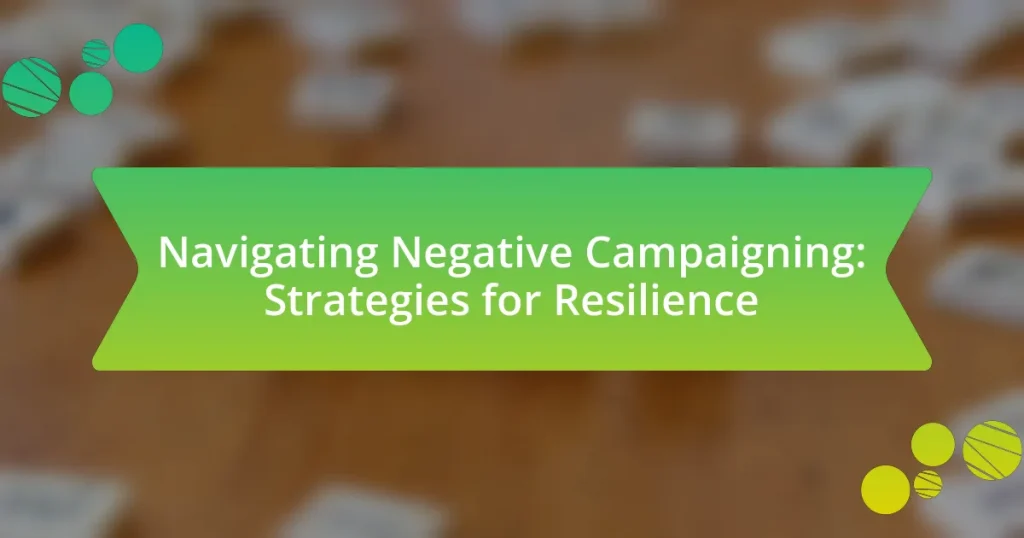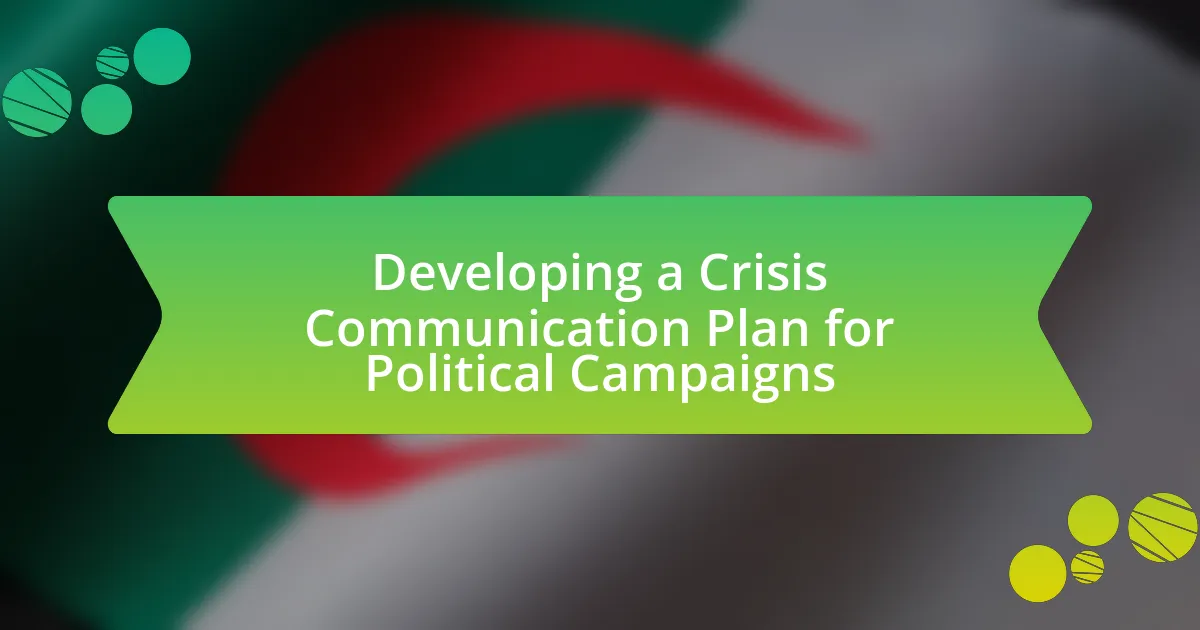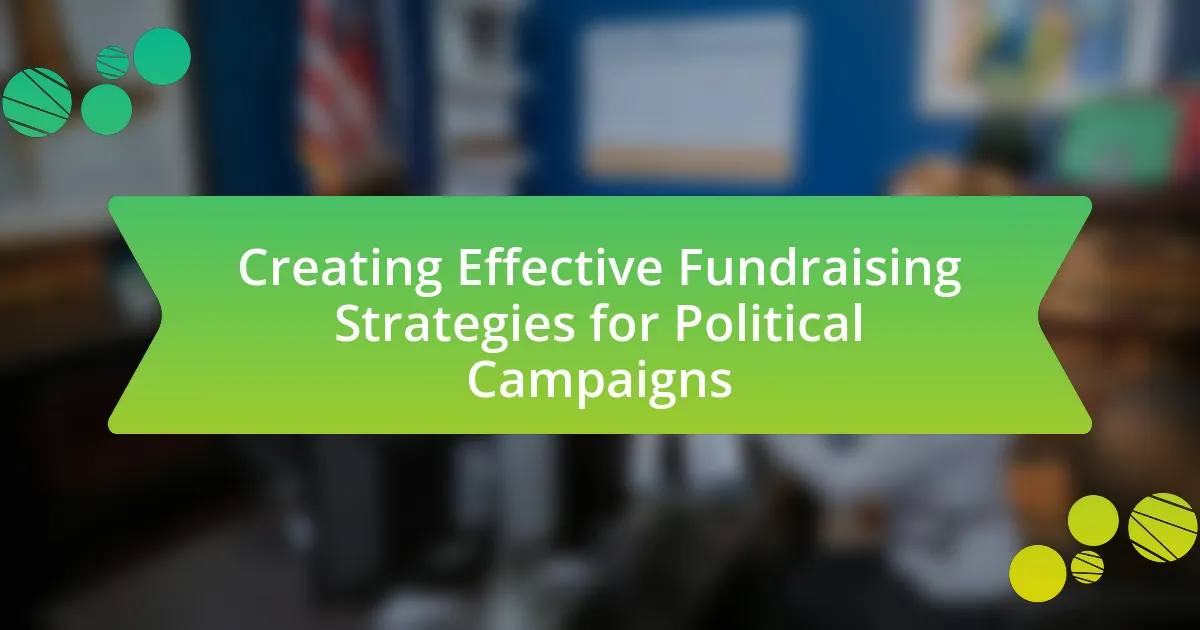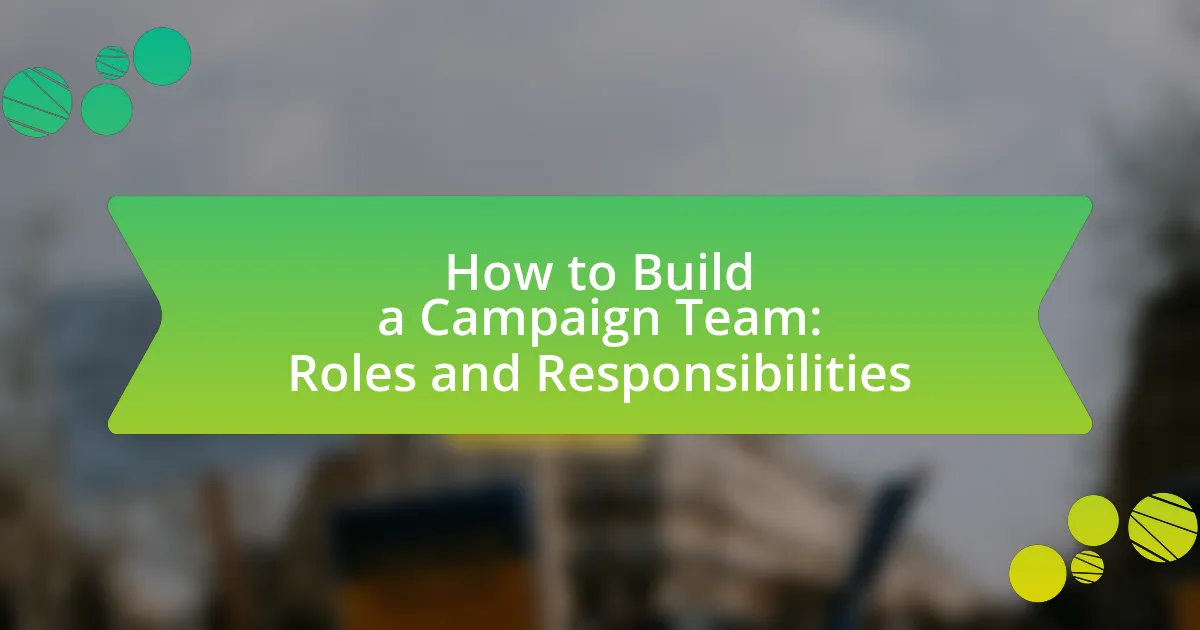Negative campaigning is a political strategy that focuses on attacking an opponent’s character and policies rather than promoting one’s own platform. This article explores the impact of negative campaigning on political discourse, voter psychology, and public perception of candidates, highlighting its potential to polarize opinions and decrease voter turnout. It also examines the strategic advantages candidates gain from employing negative tactics, the ethical implications involved, and the long-term effects on democracy. Furthermore, the article provides insights into how candidates can effectively navigate negative campaigning through communication strategies, engagement with supporters, and proactive measures to maintain a positive image amidst attacks.
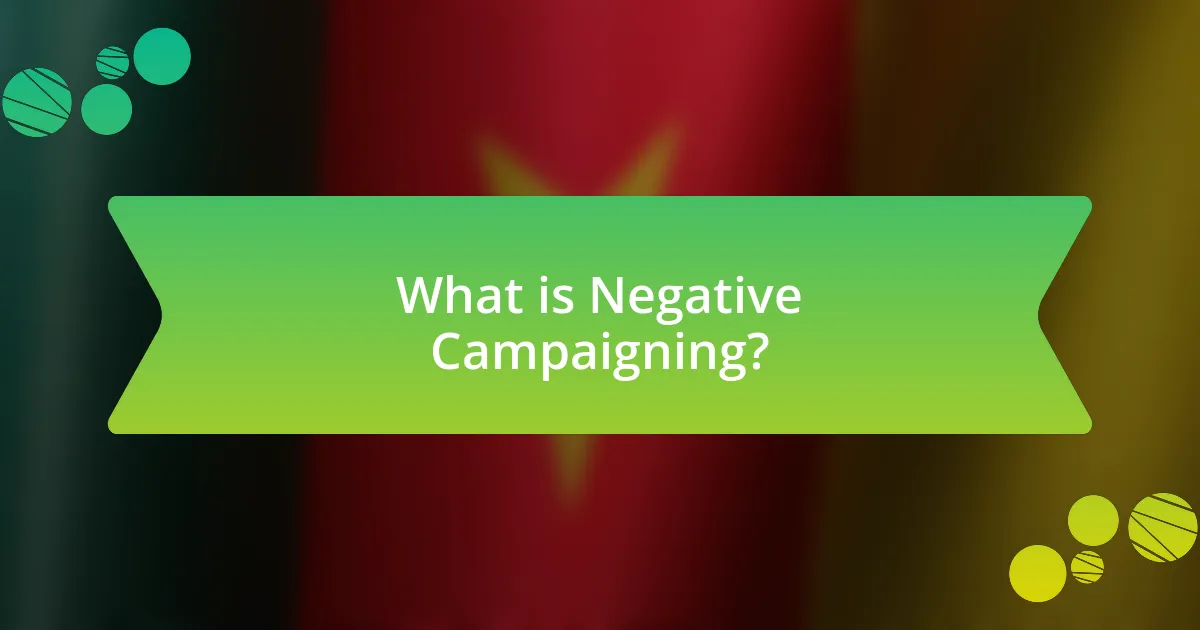
What is Negative Campaigning?
Negative campaigning is a political strategy that involves attacking an opponent’s character, policies, or qualifications rather than focusing on one’s own platform. This approach is often employed to create doubt or fear among voters regarding the opponent, aiming to sway public opinion in favor of the attacking candidate. Research indicates that negative campaigning can be effective; for instance, a study published in the Journal of Politics found that negative ads can increase voter turnout by making elections more salient.
How does Negative Campaigning impact political discourse?
Negative campaigning significantly polarizes political discourse by fostering division among voters. This tactic often emphasizes personal attacks and negative portrayals of opponents, which can lead to increased animosity and reduced willingness to engage in constructive dialogue. Research indicates that negative campaigning can decrease voter turnout, as individuals may feel disillusioned or overwhelmed by the negativity, leading to apathy towards the electoral process. A study by the American Political Science Review found that negative ads can shift public perception, making voters more likely to view candidates unfavorably, thus impacting their voting decisions.
What are the psychological effects of Negative Campaigning on voters?
Negative campaigning has significant psychological effects on voters, primarily inducing feelings of fear, anxiety, and distrust. Research indicates that exposure to negative political advertisements can lead to increased voter cynicism and decreased political efficacy, as individuals may feel disillusioned by the political process. A study by Lau and Pomper (2004) found that negative campaigning can enhance voter turnout among those who feel strongly about the issues presented, but it can also alienate moderate voters who prefer positive messaging. Furthermore, negative campaigning can create a polarized environment, leading to stronger in-group and out-group biases, which can diminish constructive political discourse.
How does Negative Campaigning influence public perception of candidates?
Negative campaigning significantly influences public perception of candidates by shaping voters’ attitudes and beliefs through the dissemination of unfavorable information. Research indicates that exposure to negative advertisements can lead to increased skepticism about the targeted candidate’s integrity and competence. For instance, a study by Ansolabehere and Iyengar (1995) found that negative political ads can decrease the favorability ratings of candidates by as much as 10%. This shift in perception often results in lower voter support and can sway undecided voters towards the opposing candidate. Furthermore, negative campaigning can create a climate of distrust, leading voters to question not only the targeted candidate but also the political system as a whole.
Why do candidates engage in Negative Campaigning?
Candidates engage in negative campaigning primarily to undermine their opponents and enhance their own chances of winning. This strategy is often employed because it can effectively sway public opinion by highlighting the perceived flaws or failures of the opponent, thereby creating doubt about their suitability for office. Research indicates that negative ads can lead to increased voter turnout, as they provoke emotional responses and drive engagement with the electoral process. For instance, a study by the American Political Science Review found that negative campaigning can lead to a 5-10% increase in voter turnout, demonstrating its effectiveness in mobilizing voters.
What strategic advantages does Negative Campaigning provide?
Negative campaigning provides strategic advantages such as increased voter engagement and the ability to differentiate candidates. By highlighting an opponent’s weaknesses, campaigns can capture public attention and provoke discussions, leading to higher voter turnout. Research indicates that negative ads can be more memorable than positive ones, enhancing recall and recognition of the candidate’s message. For instance, a study by the American Political Science Review found that negative campaigning can lead to a 5-10% increase in voter awareness and engagement, demonstrating its effectiveness in shaping electoral outcomes.
How does the competitive landscape affect the use of Negative Campaigning?
The competitive landscape significantly influences the use of negative campaigning by intensifying the urgency and necessity for candidates to differentiate themselves from their opponents. In highly competitive races, candidates may resort to negative tactics to undermine their rivals’ credibility and appeal to voters’ emotions, as evidenced by studies showing that negative ads can increase voter turnout by creating a sense of urgency and concern about the opposing candidate’s qualifications. For instance, research from the American Political Science Review indicates that negative campaigning is more prevalent in close elections, where the perceived threat from opponents drives candidates to adopt aggressive strategies to secure their position.

What are the consequences of Negative Campaigning?
Negative campaigning leads to several significant consequences, including voter apathy, increased polarization, and damage to candidates’ reputations. Research indicates that negative ads can decrease voter turnout by creating disillusionment; for instance, a study by the American Political Science Review found that exposure to negative campaigning can lower voter engagement by up to 10%. Additionally, negative campaigning often exacerbates political polarization, as it reinforces existing biases and divides among the electorate. Furthermore, candidates who engage in negative campaigning risk tarnishing their own image, as voters may perceive them as untrustworthy or unethical, which can ultimately affect their chances of winning elections.
How does Negative Campaigning affect voter turnout?
Negative campaigning typically decreases voter turnout. Research indicates that negative ads can lead to voter apathy and disillusionment, as they often create a toxic political environment. For instance, a study by the American Political Science Review found that exposure to negative campaigning can demobilize voters, particularly among those who are less politically engaged. This demobilization occurs because negative messages can foster feelings of cynicism and distrust towards the political process, leading individuals to feel that their participation will not make a difference.
What role does Negative Campaigning play in voter apathy?
Negative campaigning significantly contributes to voter apathy by fostering disillusionment and distrust among the electorate. Research indicates that when campaigns focus on attacking opponents rather than presenting positive messages, voters often feel overwhelmed and disengaged, leading to lower turnout rates. A study by the Pew Research Center found that 60% of voters reported feeling frustrated by negative ads, which can diminish their motivation to participate in elections. This pattern suggests that negative campaigning not only alienates voters but also undermines their belief in the political process, ultimately resulting in increased apathy.
How can Negative Campaigning lead to polarization among voters?
Negative campaigning can lead to polarization among voters by intensifying divisions between opposing political groups. This occurs as negative messages often emphasize the flaws or perceived threats posed by the opposing candidate, fostering an “us versus them” mentality. Research indicates that exposure to negative political ads increases partisan animosity, as voters become more entrenched in their beliefs and less willing to engage with opposing viewpoints. For instance, a study published in the Journal of Politics found that negative campaigning significantly heightened partisan identification, leading to increased polarization in voter attitudes and behaviors.
What are the ethical implications of Negative Campaigning?
Negative campaigning raises significant ethical implications, primarily concerning misinformation, manipulation, and the erosion of public trust. Misinformation can mislead voters about candidates’ qualifications or positions, as evidenced by studies showing that negative ads often distort facts to create a false narrative. Manipulation occurs when campaigns exploit emotional responses, such as fear or anger, to sway public opinion, which can undermine rational decision-making in the electoral process. Furthermore, the prevalence of negative campaigning contributes to a general erosion of trust in political institutions, as research indicates that exposure to negative ads can lead to increased cynicism among voters, diminishing their engagement in the democratic process. These ethical concerns highlight the need for accountability and transparency in political advertising to preserve the integrity of elections.
How do ethical considerations shape the strategies used in Negative Campaigning?
Ethical considerations significantly influence the strategies employed in negative campaigning by establishing boundaries on acceptable tactics and messaging. Campaigns must navigate the fine line between highlighting an opponent’s flaws and engaging in misinformation or personal attacks, as crossing this line can lead to public backlash and damage to the campaign’s credibility. For instance, research indicates that campaigns that adhere to ethical standards tend to maintain voter trust and engagement, while those that resort to unethical tactics often face negative repercussions, such as decreased voter turnout and increased polarization. Therefore, ethical considerations not only guide the choice of strategies but also impact the overall effectiveness and public perception of negative campaigning.
What are the potential long-term effects of Negative Campaigning on democracy?
Negative campaigning can lead to long-term erosion of public trust in democratic institutions. This occurs as voters become disillusioned with the political process, perceiving it as increasingly hostile and divisive. Research indicates that sustained exposure to negative campaigning can decrease voter turnout, as individuals may feel that their participation will not lead to positive change. For instance, a study by the Pew Research Center found that negative ads can contribute to voter apathy, with 60% of respondents expressing frustration with the tone of political discourse. Additionally, negative campaigning can polarize the electorate, fostering an environment where compromise becomes difficult, ultimately undermining democratic governance.

How can candidates navigate Negative Campaigning effectively?
Candidates can navigate negative campaigning effectively by maintaining a focus on their core message and values while addressing attacks directly and transparently. This approach allows candidates to reinforce their identity and counter misinformation. For instance, research indicates that candidates who respond to negative ads with positive messaging about their own qualifications can mitigate the impact of those ads, as seen in the 2012 U.S. presidential election where Barack Obama’s campaign successfully countered negative ads by emphasizing his achievements. By staying authentic and engaging with voters through direct communication, candidates can build trust and resilience against negative tactics.
What strategies can candidates employ to build resilience against Negative Campaigning?
Candidates can build resilience against negative campaigning by developing a strong support network, maintaining a positive public image, and focusing on their core message. A strong support network, including family, friends, and campaign staff, provides emotional backing and strategic advice during challenging times. Maintaining a positive public image helps counteract negative narratives; for instance, candidates can engage in community service or highlight their achievements to reinforce their credibility. Focusing on their core message allows candidates to stay grounded and redirect conversations back to their policies and vision, which can diminish the impact of negative attacks. Research indicates that candidates who effectively manage their public perception and maintain a clear, consistent message are more likely to withstand the effects of negative campaigning.
How can candidates maintain a positive image amidst Negative Campaigning?
Candidates can maintain a positive image amidst negative campaigning by consistently communicating their core values and achievements. This approach allows candidates to reinforce their identity and counteract negative narratives. For instance, during the 2008 U.S. presidential election, Barack Obama effectively highlighted his vision and accomplishments, which helped him maintain a favorable public perception despite facing significant negative attacks. Additionally, candidates should engage directly with their audience through social media and public forums, providing transparent responses to criticisms. This strategy fosters trust and demonstrates accountability, further solidifying their positive image.
What role does communication play in countering Negative Campaigning?
Communication plays a crucial role in countering negative campaigning by enabling candidates to effectively address misinformation and reinforce their positive messages. Through clear and transparent communication, candidates can directly respond to attacks, clarify their positions, and maintain public trust. For instance, research indicates that campaigns that engage in proactive communication strategies, such as fact-checking and direct voter outreach, can mitigate the impact of negative ads by up to 30%. This demonstrates that strategic communication not only counters false narratives but also strengthens a candidate’s overall message, fostering resilience against negative campaigning.
How can candidates respond to Negative Campaigning?
Candidates can respond to negative campaigning by maintaining a positive message, addressing the attacks directly, and focusing on their qualifications and vision. By consistently promoting their own policies and achievements, candidates can counteract the negativity and reinforce their credibility. Research indicates that candidates who emphasize their strengths and remain composed during negative attacks are more likely to retain voter support, as seen in the 2008 U.S. presidential election where Barack Obama effectively countered negative ads by highlighting his vision for change.
What are effective rebuttal strategies against Negative Campaigning?
Effective rebuttal strategies against negative campaigning include direct fact-checking, reframing the narrative, and emphasizing positive messaging. Direct fact-checking involves publicly correcting false claims made in negative ads, which can diminish their credibility; for instance, organizations like FactCheck.org provide resources to verify claims. Reframing the narrative shifts focus from the negative attack to the candidate’s strengths or positive vision, helping to regain control of the conversation. Emphasizing positive messaging involves consistently communicating the candidate’s achievements and future plans, which can counteract the negativity and reinforce voter support. These strategies have been shown to mitigate the impact of negative campaigning, as evidenced by studies indicating that voters respond more favorably to candidates who maintain a positive message amidst attacks.
How can candidates leverage social media to combat Negative Campaigning?
Candidates can leverage social media to combat negative campaigning by actively engaging with their audience and promoting positive narratives. By consistently sharing authentic content that highlights their values, achievements, and vision, candidates can counteract misinformation and negative portrayals. Research indicates that 69% of voters use social media to gather information about candidates, making it a crucial platform for shaping public perception. Furthermore, candidates can utilize real-time responses to address false claims, thereby fostering transparency and trust. Engaging directly with supporters through comments and live sessions can also create a sense of community, which helps to mitigate the impact of negative campaigning.
What best practices can candidates adopt to mitigate the effects of Negative Campaigning?
Candidates can mitigate the effects of negative campaigning by maintaining a positive message and focusing on their strengths. By consistently communicating their vision, policies, and achievements, candidates can create a strong narrative that counters negative attacks. Research indicates that candidates who emphasize their qualifications and positive attributes are more likely to retain voter support, even in the face of negative campaigning. Additionally, engaging directly with voters through town halls and social media allows candidates to clarify misinformation and build trust, further reducing the impact of negative tactics.
How can candidates engage with their supporters to foster resilience?
Candidates can engage with their supporters to foster resilience by maintaining open communication and providing consistent updates on campaign progress and challenges. This approach builds trust and encourages supporters to remain committed during difficult times. Research indicates that transparent communication can enhance supporter loyalty, as seen in the 2020 U.S. presidential election, where candidates who actively engaged with their base through social media and town halls reported higher levels of supporter morale and resilience against negative campaigning.
What proactive measures can candidates take to prepare for Negative Campaigning?
Candidates can prepare for negative campaigning by developing a comprehensive communication strategy that includes anticipating potential attacks, crafting clear and consistent messaging, and engaging in proactive public relations efforts. By researching opponents’ past behaviors and statements, candidates can identify vulnerabilities and prepare counter-narratives. Additionally, training staff and volunteers on how to respond to negative messages ensures a unified front. Historical examples, such as Barack Obama’s 2008 campaign, demonstrate the effectiveness of preemptive messaging and rapid response teams in mitigating the impact of negative campaigning.
